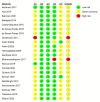Effect of Motor Imagery Training on Motor Learning in Children and Adolescents: A Systematic Review and Meta-Analysis
- PMID: 34574389
- PMCID: PMC8465066
- DOI: 10.3390/ijerph18189467
Effect of Motor Imagery Training on Motor Learning in Children and Adolescents: A Systematic Review and Meta-Analysis
Abstract
Background: There is an urgent need to systematically analyze the growing body of literature on the effect of motor imagery (MI) training in children and adolescents. Methods: Seven databases and clinicaltrials.gov were searched. Two reviewers independently screened references and full texts, and extracted data (studies' methodology, MI elements, temporal parameters). Two studies were meta-analyzed providing the standard mean difference (SDM). Selected studies were evaluated with the risk of bias (RoB) and GRADE tools. Results: A total of 7238 references were retrieved. The sample size of the 22 included studies, published between 1995 and 2021, ranged from 18 to 136 participants, totaling 934 (nine to 18 years). Studies included healthy pupils, mentally retarded adolescents, children with motor coordination difficulties or with mild mental disabilities. The motor learning tasks focused on upper, lower and whole body movements. SMDs for the primary outcome of pooled studies varied between 0.83 to 1.87 (95% CI, I2, T2 varied 0.33-3.10; p = 0.001; 0-74%; 0-0.59). RoB varied between some concerns and high risk. GRADE rating was low. Conclusions: MI combined with physical practice (PP) might have a high potential for healthy and impaired children and adolescents. However, important reporting recommendations (PETTLEP, TIDieR, CONSORT) should be followed. The systematic review was registered with PROSPERO: CRD42021237361.
Keywords: PETTLEP; children and adolescents; mental practice; motor imagery training; randomized controlled trial; systematic review and meta-analysis.
Conflict of interest statement
The authors declare no conflict of interest.
Figures






References
Publication types
MeSH terms
LinkOut - more resources
Full Text Sources
Miscellaneous

